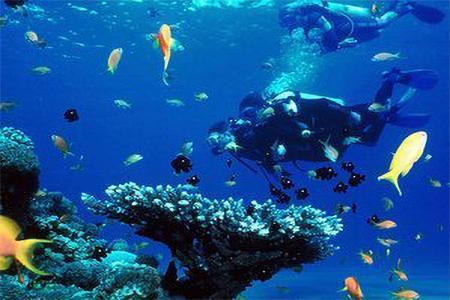Sri Lanka is an amazing diving destination with a diverse underwater ecology that includes Reefs, Caves, Ruins, and Wrecks. Sri Lanka over 50 interesting wrecks all around the island.
Sri Lanka is recognized as one of the top 100 wreck dives in the world. The shipwrecks scattered off the coast are covered in marine life, soft corals, macro critters, and large aggregations of schooling fish. We have over 50 interesting wrecks all around the island that even belong to World War I and II including the famous aircraft carrier HMS Hermes (1942), SS British Sergeant (1942), HMS Hollyhock (1942), and RMS Athelstane (1942).
Blue whales and sperm whales are the biggest seasonal sightings.
Additional information
Best time and popular spots
Diving is possible in Sri Lanka year-round depending on the seasonal monsoon of the region.
October to April
- West Coast
Colombo
Colombo has some of the greatest wreck diving in Sri Lanka, with wrecks ranging in depth from 30 to 57 meters. Taprobane Reefs and the magnificent Gorgonian Gardens are other fantastic reef sites near Colombo city.
Negombo
Negombo is located 60 minutes north of Colombo, provides access to colorful inshore reefs filled with fish, as well as the offshore reefs of Final Frontier. Many popular dives in this region include Barracuda Point, Derana Gala, and the wreckage of a WWII fighter jet.
Kalpitiya
The Bar Reef of Kalpitiya is Sri Lanka’s biggest reef system and a protected marine sanctuary. The Bar Reef is home to several coral types and tropical fish species, making it one of the most diversified marine ecosystems in this region of the Indian Ocean.
- Southwest Coast
Beruwala
Deeper offshore spots with strong currents attract massive shoals of fish to the west coast of Beruwala. This is a spectacular site appropriate for more experienced divers, with stunning rock formations and good visibility.
Hikkaduwa
Despite its small size, this west coast town is upscale, with luxury resorts lining the coastline and the main street lined with stores and fine restaurants. Around 20 minutes from shore, there are a variety of dive spots with varying depths. Underwater topography in the shape of caverns and overhangs hides a plethora of macro photography chances.
- South Coast
Galle
Galle’s Underwater Museum Sri Lanka’s first underwater museum is located shoreline near Galle port. Galle underwater museum is 16 to 18 meters deep in the sea. And also, there are several shipwreck sites where unique fish and colorful corals can be found.
Unawatuna
Unawatuna is famous for miles of golden sandy beaches, but it also has outstanding west coast diving, with several wrecks and rocky formations covered in black coral. This is one of the greatest spots to see Napoleon wrasse regularly.
May to September
- East Coast
Trincomalee
Japanese Zero aircraft and British Hurricanes that sank during WWII are among the well-known wrecks in Trincomalee’s waters.
There are also numerous reef dives here, including Eel Rock, which is home to at least five distinct types of moray eel, Black Tip Rock, where around 20 reef sharks congregate each morning, and White Rock, where various ray species can be observed.
Kalmunai
The SS Athelstane and HMS Hollyhock are significant WWII wrecks at Kalmunai. Both wrecks are in 42m of water, are quite picturesque, and are teeming with life. The MV Ledra, a third wreck, is significantly shallower but has less to offer than the others.
Batticaloa
There are multiple wrecks and reefs covered in stunning corals and sponges close to the shore. This environment creates an underwater jungle ecosystem alive with marine life swarming with big shoals of rainbow runners, fusilier, and sweetlips,
The HMS Hermes aircraft wreck is one of the most well-known. During WWII, it was bombed and sunk by the Japanese. Only technically certified divers may approach the wreck, which is located in 53 meters of water. Every surface of the superstructure is covered in forests of gorgonians and soft corals.
- Southeast Coat
Kirinda
Another offshore reef system lies roughly 10 Km off the southeast coast, there are various places here enabling encounters with bigger pelagic and sea species. Among the shipwrecks, coral gardens, caves, and ruins, brisk currents attract jacks, trevally, and white-tipped reef sharks.

